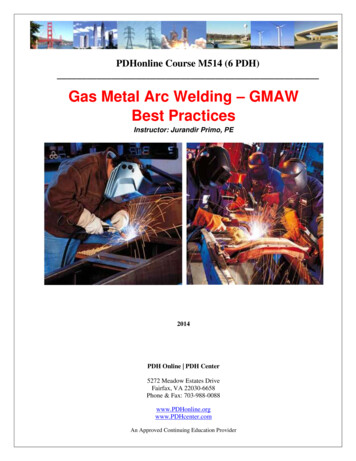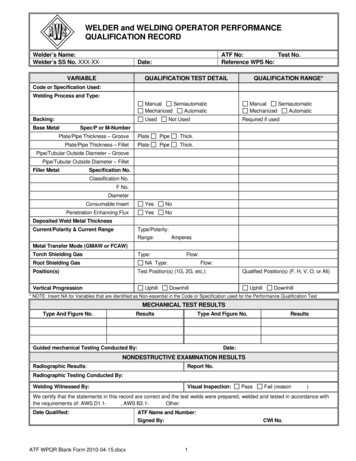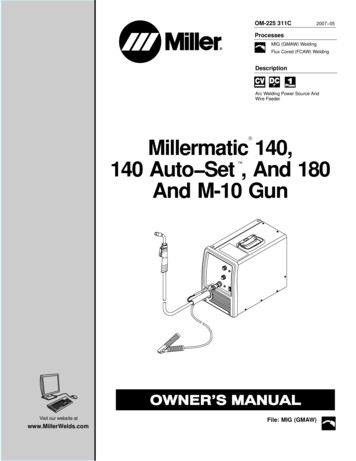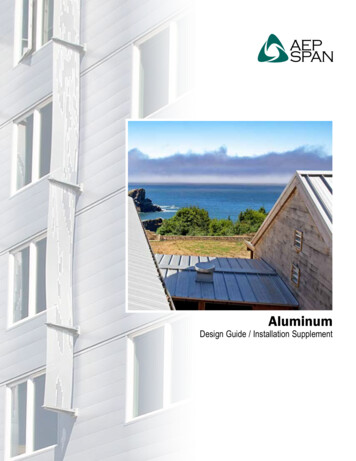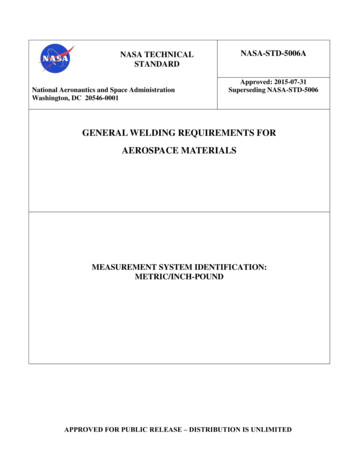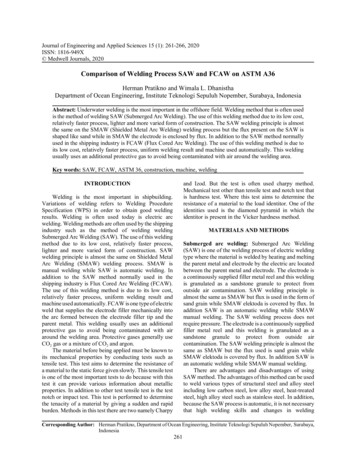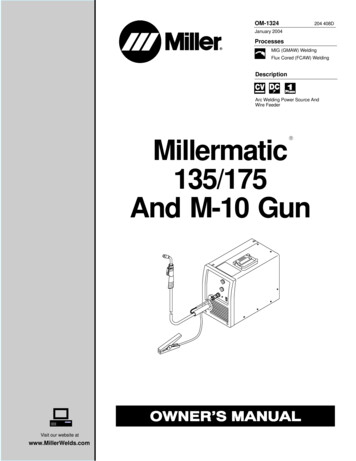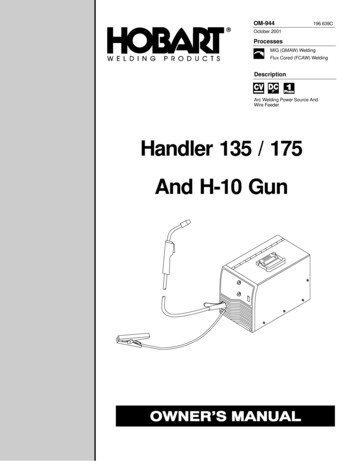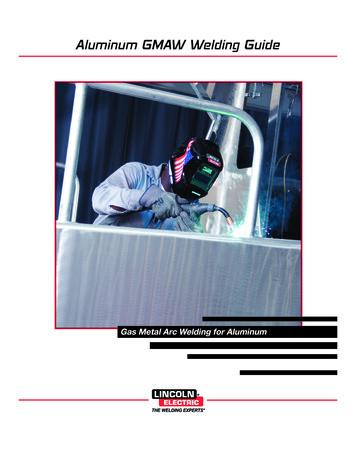
Transcription
Aluminum GMAW Welding GuideGas Metal Arc Welding for Aluminum
About The LincolnElectric Company Lincoln Electric is the world’s leadingmanufacturer of welding equipment andconsumables. Our focus is on helpingcompanies make their weldingoperations more effective, moreefficient, more profitable.We are dedicated to two equallyimportant goals: exceptional quality andexceptional service. Our field supportteam –– with hundreds of field salesengineers and thousands ofknowledgeable and responsive Lincoln distributors in countries all over theworld –– is the largest in the industry.Innovative thinking.A quality, service-first attitude.Fresh approaches to design,manufacturing, and packaging.Worldwide strength.That’s Lincoln Electric .L i n c o l n ’s Super Glaze Te c h n o l o g yFor superior welding performance, turn to Super Glaze aluminumMIG wire from Lincoln Electric . Super Glaze prevents the problemsusually associated with aluminum wire feeding such as birdnesting,tangling and burnback to provide a stable arc, great feedability andexceptional control –– every time you weld! The keys are SuperGlaze’s smooth surface finish and consistent chemical composition.What this means for you is quality wire that produces a quality weld.Let Us Put Our Experience to Work for YouAs a major supplier of welding wire, Lincoln Electric is the leader inMIG wire manufacturing technology. We carry that same technologyand expertise to our aluminum MIG wire manufacturing. Our fullyintegrated aluminum MIG wire facility uses state-of-the-art equipmentto produce a complete range of aluminum alloys including 1100, 40434047, 5183, 5356, 5554 and 5556.What Makes Our Super Glaze Stand Out From the Rest?Three unique features:1. A proprietary process which gives Super Glaze a superior surfacefinish for optimum surface integrity.2. A manufacturing process that precisely controls the alloy chemicalcomposition to produce consistent physicalcharacteristics.3. State-of-the-art testing equipment to evaluate thesurface condition and feedability of the wire to ensureproblem-free welding.What all this means to you is outstanding welding characteristics, spoolto spool, time after time. Lincoln’s aluminum MIG wire coupled with ouradvanced MIG welding equipment makes aluminum as easy to weld asany other material. and makes Lincoln the one source for all youraluminum welding needs.Important Information on our WebsiteConsumable AWS ificates/Material Safety Data Sheets (MSDS):www.lincolnelectric.com/products/msds/ANSI Z49.1 Safety in Welding and Cutting and Arc WeldingSafety /Request E205 Safety rature/e205.pdfAluminum2www.lincolnelectric.com
Here’s How Our Process Works:Controlling AlloysThe process of making aluminum MIG wires is a complex one,but one in which Lincoln has a clear and distinct advantage.First, we utilize automated titling furnaces to efficiently producethe proper aluminum alloys. With this equipment, we are able tohold tight tolerances in the composition. The alloy is carefullyrefined prior to casting to minimize hydrogen, alkaline metals,and inclusions.With our MIG welding process knowledge, we understand thatwelding performance is one of the most important criteria usedwhen selecting a wire. Aluminum MIG wire tends to produce awelding arc that is less stable than other materials becausealuminum conducts electricity better. Small changes in wirediameter, wire feed speed, and current produce dramaticchanges in weld bead profile, arc length and can even causeequipment downtime due to wire burnback and fusing to tip.Our continuous evaluation of finished product ensuresconsistency in manufacturing. You can count on Lincoln Continuous CastingSecond, we use a continuous casting process speciallyconfigured to high alloy materials. This process keeps thesurface free from imperfections and impurities.aluminum MIG wire for superior arc stability, weld appearance,integrity and productivity.ExcellentLincolnSuperGlaze ProductFeedabilityDrawing the WireIn the last manufacturing step of the process, we use advancedwire drawing technology to preserve both surface integrity andinternal soundness.Testing the WireTo ensure superior quality of welding wire, continuous finishedproduct inspection is done. Surface quality is evaluated alongwith feedability and welding performance. This guarantees everyspool of wire is problem-free.TypicalCompetitiveProductPoorWire Jams and Stops FeedingWelding PerformanceMost aluminum MIG welding problems are caused by poorfeeding. Since aluminum is relatively soft, it is important that thewire surface be as smooth aspossible for best feedability.The SuperGlaze AdvantageSuper Glaze products provide5356 Wire Surfaces Magnified 60xeasier feeding than competitiveproducts because they havefewer surface imperfections asshown at the right.Super Glaze wire also feedswith less force than typicalcompetitive products as thefeedability test graph shows.SuperGlazeWhat this means is better“Best in Class”control of the weld puddle forthe operator. t also means longerTypical Competitivegun liner and contact tip life asProductburnbacks do not occur.TimeAluminum3www.lincolnelectric.com
ContentsPageEffects of Alloying Elements . . . . . . . . . . . . . . . . . . . . . . . . . . . . . . . . . . . . . . . . . . . . . . . . . . . . . . . . . . . . . . . . . 5-9Introduction . . . . . . . . . . . . . . . . . . . . . . . . . . . . . . . . . . . . . . . . . . . . . . . . . . . . . . . . . . . . . . . . . . . . . . . . . . . 5Welding Aluminum vs. Welding Steel . . . . . . . . . . . . . . . . . . . . . . . . . . . . . . . . . . . . . . . . . . . . . . . . . . . . . . . 5Metallurgy . . . . . . . . . . . . . . . . . . . . . . . . . . . . . . . . . . . . . . . . . . . . . . . . . . . . . . . . . . . . . . . . . . . . . . . . . . 5-7Aluminum Alloys . . . . . . . . . . . . . . . . . . . . . . . . . . . . . . . . . . . . . . . . . . . . . . . . . . . . . . . . . . . . . . . . . . . 6Wrought Alloys . . . . . . . . . . . . . . . . . . . . . . . . . . . . . . . . . . . . . . . . . . . . . . . . . . . . . . . . . . . . . . . 6Cast Alloys . . . . . . . . . . . . . . . . . . . . . . . . . . . . . . . . . . . . . . . . . . . . . . . . . . . . . . . . . . . . . . . . . . . 6Alloying Elements . . . . . . . . . . . . . . . . . . . . . . . . . . . . . . . . . . . . . . . . . . . . . . . . . . . . . . . . . . . . . . . . . . . . . 6-7Temper Designations . . . . . . . . . . . . . . . . . . . . . . . . . . . . . . . . . . . . . . . . . . . . . . . . . . . . . . . . . . . . . . . . . . 7-8Effects of Welding on Aluminum Alloys . . . . . . . . . . . . . . . . . . . . . . . . . . . . . . . . . . . . . . . . . . . . . . . . . . . . . . . . . . 9Nonheat-treatable Alloys . . . . . . . . . . . . . . . . . . . . . . . . . . . . . . . . . . . . . . . . . . . . . . . . . . . . . . . . . . . . . . . . . 9Heat-treatable Alloys . . . . . . . . . . . . . . . . . . . . . . . . . . . . . . . . . . . . . . . . . . . . . . . . . . . . . . . . . . . . . . . . . . . . 9Filler Metal Selection . . . . . . . . . . . . . . . . . . . . . . . . . . . . . . . . . . . . . . . . . . . . . . . . . . . . . . . . . . . . . . . . . . . . . 10-12Aluminum Filler Alloys . . . . . . . . . . . . . . . . . . . . . . . . . . . . . . . . . . . . . . . . . . . . . . . . . . . . . . . . . . . . . . . 10-11Aluminum Filler Metal Guide . . . . . . . . . . . . . . . . . . . . . . . . . . . . . . . . . . . . . . . . . . . . . . . . . . . . . . . . . . . . . 12Welding Preparation . . . . . . . . . . . . . . . . . . . . . . . . . . . . . . . . . . . . . . . . . . . . . . . . . . . . . . . . . . . . . . . . . . . . . 13-14Storage and Handling of Aluminum Prior to Welding . . . . . . . . . . . . . . . . . . . . . . . . . . . . . . . . . . . . . . . . . 13Forming the Weld Preparation . . . . . . . . . . . . . . . . . . . . . . . . . . . . . . . . . . . . . . . . . . . . . . . . . . . . . . . . . . . 13Pre-weld Cleaning . . . . . . . . . . . . . . . . . . . . . . . . . . . . . . . . . . . . . . . . . . . . . . . . . . . . . . . . . . . . . . . . . . 13-14GMAW of Aluminum Alloys . . . . . . . . . . . . . . . . . . . . . . . . . . . . . . . . . . . . . . . . . . . . . . . . . . . . . . . . . . . . . . . . 15-18Properties of Aluminum . . . . . . . . . . . . . . . . . . . . . . . . . . . . . . . . . . . . . . . . . . . . . . . . . . . . . . . . . . . . . . . . . 15Modes of Metal Transfer . . . . . . . . . . . . . . . . . . . . . . . . . . . . . . . . . . . . . . . . . . . . . . . . . . . . . . . . . . . . . . . . 15GMAW Power Supplies . . . . . . . . . . . . . . . . . . . . . . . . . . . . . . . . . . . . . . . . . . . . . . . . . . . . . . . . . . . . . . 15-16GMAW-P Power Supplies . . . . . . . . . . . . . . . . . . . . . . . . . . . . . . . . . . . . . . . . . . . . . . . . . . . . . . . . . . . . . . . 16Wire Drives and Controls . . . . . . . . . . . . . . . . . . . . . . . . . . . . . . . . . . . . . . . . . . . . . . . . . . . . . . . . . . . . . 16-17Push and Push-Pull Type Feeders . . . . . . . . . . . . . . . . . . . . . . . . . . . . . . . . . . . . . . . . . . . . . . . . . 16-17Push-Pull GMAW Torches and Spool Guns . . . . . . . . . . . . . . . . . . . . . . . . . . . . . . . . . . . . . . . . . . . . 17Aluminum Feeding Enhancement . . . . . . . . . . . . . . . . . . . . . . . . . . . . . . . . . . . . . . . . . . . . . . . . . . . . . . . . . 17Shielding Gas . . . . . . . . . . . . . . . . . . . . . . . . . . . . . . . . . . . . . . . . . . . . . . . . . . . . . . . . . . . . . . . . . . . . . . . . . 18Welding Techniques . . . . . . . . . . . . . . . . . . . . . . . . . . . . . . . . . . . . . . . . . . . . . . . . . . . . . . . . . . . . . . . . . . . 18Welding Defects — Causes and Cures . . . . . . . . . . . . . . . . . . . . . . . . . . . . . . . . . . . . . . . . . . . . . . . . . . 19-20Solving Problems in Qualifying Weld Procedures . . . . . . . . . . . . . . . . . . . . . . . . . . . . . . . . . . . . . . . . . . . . 21Meeting Tensile Test Requirements . . . . . . . . . . . . . . . . . . . . . . . . . . . . . . . . . . . . . . . . . . . . . . . . 21-22Meeting Bend Test Requirements . . . . . . . . . . . . . . . . . . . . . . . . . . . . . . . . . . . . . . . . . . . . . . . . . 21-22General Welding Guidelines . . . . . . . . . . . . . . . . . . . . . . . . . . . . . . . . . . . . . . . . . . . . . . . . . . . . . . . . . . . . . . . 23-26Typical Melting Rates . . . . . . . . . . . . . . . . . . . . . . . . . . . . . . . . . . . . . . . . . . . . . . . . . . . . . . . . . . . . . . . . . . 23Current vs. Wire Feed Speed . . . . . . . . . . . . . . . . . . . . . . . . . . . . . . . . . . . . . . . . . . . . . . . . . . . . . . . . . . . . 23Welding Joint Design for Groove Welding . . . . . . . . . . . . . . . . . . . . . . . . . . . . . . . . . . . . . . . . . . . . . . . 24-25Welding Guidelines for Fillet and Lap Welding . . . . . . . . . . . . . . . . . . . . . . . . . . . . . . . . . . . . . . . . . . . . . . . 26Safety Practices . . . . . . . . . . . . . . . . . . . . . . . . . . . . . . . . . . . . . . . . . . . . . . . . . . . . . . . . . . . . . . . . . . . . . . . . 27-30Aluminum4www.lincolnelectric.com
Effects of Alloying ElementsThe balance of this guide will discuss these differences and howto overcome them. They can all be summed up in threestatements:IntroductionThe use of aluminum as a structural material is fairly recent. Infact, when the Washington Monument was completed inDecember, 1884, it was capped with a 100-ounce pyramid ofpure aluminum, because aluminum was considered to be aprecious metal at that time. The problem that impeded the useof aluminum is that it is a reactive metal. It is never found in itselemental state in nature, but is always tightly bound withoxygen as aluminum oxide, Al2O3. Although aluminum oxide,found as bauxite ore, is plentiful, no direct reduction method,such as they used to make steel, has ever been found to producealuminum from bauxite.I. If you take enough care almost all steels are weldable.There are some aluminum alloys that just are not arc weldable.Fabricators fall into this trap regularly. We’ll discuss theweldability of the various alloy families in detail. At this point, let’sjust say that many aluminum alloys, and especially the strongerones, are not weldable.2. All steels are heat-treatable. Some aluminum alloys areheat-treatable, but some are not.It was only after the American Charles M. Hall and theFrenchman Paul Heroult almost simultaneously, but independently, discovered electrolytic processes for obtaining purealuminum from aluminum oxide (in 1886) that aluminum becameavailable in commercial quantities. These processes, with somemodifications, are still used today. In large part, it is the extremelylarge amount of electrical power required to produce aluminumthat accounts for its higher cost relative to steel.Even for the heat-treatable aluminum alloys, the heat treatmentsare totally different from those used for steel. In fact, if you heatup some alloys and quench them, they will become softer, notharder. Be aware of the differences and act accordingly.Since that time, aluminum has found wide use in numerousapplications: It conducts electricity and heat almost as well as copper.This is usually true for welds in both heat treatable and nonheattreatable alloys. The strength difference between the weld orheat affected zone (HAZ) and the parent material is oftensignificant, often 30% or more.3. When welding steels, you can almost always make a weldthat is as strong as the parent material. In aluminum alloys,the weld will rarely be as strong as the parent material. It is widely used in electrical bus bars and other conductors,heat exchangers of all kinds, and cookware.Metallurgy It does not become brittle with decreasing temperature, butdoes become stronger, so it has found wide application incryogenic equipment at temperatures as low as –452 F(-269 C).To understand aluminum, we must first understand some basicsabout aluminum metallurgy. Aluminum can be alloyed with anumber of different elements, both primary and secondary, toprovide improved strength, corrosion resistance, and generalweldability. It is very corrosion resistant in most environments, so it hasfound wide applications in marine and chemical environments.The primary elements that alloy with aluminum are copper, silicon,manganese, magnesium and zinc. It is important to note thataluminum alloys fall into two classes: heat-treatable ornonheat-treatable.The characteristics of aluminum alloys which make themattractive as structural materials are their light weight (one thirdthe weight of steel for equal volumes) and their relatively highstrength (equal in many cases to that of construction steelgrades). This combination has resulted in increased use ofaluminum alloys in applications such as passenger automobiles,trucks, over-the-road trailers, and railroad cars. Additionally, thestructure of most aircraft is fabricated mainly from aluminumalloys, although in these applications, pieces are most oftenjoined by riveting.Heat-treatable alloys are those that are heat-treated to increasetheir mechanical properties. To heat treat an alloy means heatingit at a high temperature, putting the alloying elements into solidsolution and then cooling it at a rate which will produce a supersaturated solution. The next step in the process is to maintain itat a lower temperature long enough to allow a controlledamount of precipitation of the alloying elements.Welding Aluminum vs. Welding SteelWith the nonheat-treatable alloys it is possible to increasestrength only through cold working or strain hardening. To dothis, a mechanical deformation must occur in the metalstructure, resulting in increased resistance to strain, producinghigher strength and lower ductility.Most welders start out by learning how to weld steel. Some latermove over to welding aluminum. Most welding equipment isdesigned to weld steel, with welding of aluminum alloys oftenbeing an afterthought, although this is changing. Very often weapproach welding of aluminum as if it was just shiny steel.However, there are differences between steel and aluminum thatusually make this approach doomed to failure.Aluminum5www.lincolnelectric.com
Aluminum AlloysTable 2 — Cast Alloy DestinationsMuch in the same manner that the American Iron and SteelInstitute (AISI) registers steel chemistries and grades, theAluminum Association (AA) registers alloy designations,chemistries, and mechanical properties for aluminum alloys.However, the alloy designation system is totally different thanthat used for steels. Additionally, different designation systemsare used for wrought and cast alloys.AlloyFamilyWrought AlloysWrought alloy designations use a four digit number, plus atemper designation, discussed later. Aluminum alloys arebroken up into eight "families" depending on the main alloyingelements. The aluminum alloy families are shown in Table 1,along with their heat treatability.Main Alloying ElementsHeatTreatable1XX.XPure AluminumNo2XX.XCopperYes3XX.XSilicon plus t UsedNA7XX.XZincYes8XX.XTinNo9XX.XOtherTable 1: Wrought Alloy DestinationsAlloyFamilyMain Alloying Elements1XXXPure AluminumNo2XXXCopper (sometimes with magnesium)Yes3XXXManganese (sometimes with ium plus siliconYes7XXXZinc (sometimes with magnesium and copper)8XXXAll othersAlloying ElementsHeatTreatablePure Aluminum (1XXX series) Contains no alloying elements,and is not heat-treatable. It is used primarily in chemical tanksand pipe because of its superior corrosion resistance. This seriesis also used in electrical bus conductors because of its excellentelectrical conductivity. It is welded easily with 1100 and 4043 fillerwires.Copper (2XXX series) Provides high strength to aluminum. Thisseries is heat-treatable and mainly used in aircraft parts, rivetsand screw products. Most 2XXX series alloys are consideredpoor for arc welding because of their sensitivity to hot cracking.Most of these alloys should not be welded, however, alloys2014, 2219 and 2519 are easily welded with 4043 or 2319 fillerwire. These three alloys are widely used in welded fabrication.YesNormallyYesNOTE: The designation 2XXX, etc. is an industry standard abbreviationused to mean “all the alloys in the 2000 series”.Manganese (3XXX series) Yields a nonheat-treatable seriesused for general-purpose fabrication and build-up. Moderate instrength, the 3XXX series is used for forming applicationsincluding utility and van trailer sheet. It is improved through strainhardening to provide good ductility and improved corrosionproperties. Typically welded with 4043 or 5356 filler wire, the3XXX series is excellent for welding and not prone to hot cracking.Its moderate strengths prevent this series from being used instructural applications.For example, if you have a piece of 6061, it’s clear that it is awrought alloy (4 digits), it’s heat treatable, and it containsmagnesium and silicon. The second digit of the four showswhether the alloy is the first such alloy registered, in which casethe second digit will be "0", as in 5054. Digits other than "0"indicate that the alloy is a modification of a registered alloy. 5154would be the first modification of 5054. Alloy 5754 is theseventh modification. The last two digits are assigned arbitrarilyby the Aluminum Association when the alloy is registered. Notethere is no indication of alloy or weld strength given by thematerial designation.Silicon (4XXX series) Silicon reduces the melting point of thealuminum and improves fluidity. Its principle use is as filler metal.The 4XXX series has good weldability and is considered anonheat-treatable alloy. Alloy 4047 is often used in theautomotive industry as it is very fluid and good for brazing andwelding.Cast AlloysThe designation system for cast alloys are classified into familiesas shown in Table 2. The specific families are somewhatdifferent from the designations for wrought alloys and thedesignations have only three digits followed by a decimal pointand one more digit. For these alloys, the first digit shows thealloy family. The next two digits are arbitrarily assigned. Alloymodifications are shown by a letter prefix, so 356 is the originalversion of an alloy and A356 is the first modification, B356 is thesecond modification, etc. The number following the decimalpoint designates whether the alloy is produced as a casting offinal form or is produced as an ingot for re-melting.Magnesium (5XXX series) When added to aluminum,magnesium has excellent weldability, good structural strengthand is not prone to hot cracking. In fact, the 5XXX series has thehighest strength of the nonheat-treatable aluminum alloys. It isused for chemical storage tanks and pressure vessels as well asstructural applications, railway cars, dump trucks and bridgesbecause of its corrosion resistance.Aluminum6www.lincolnelectric.com
takes place. However, if the alloy is deformed at lowertemperatures, it will gain strength. In general:Silicon and Magnesium (6XXX series) This medium strength,heat-treatable series, is primarily used in automotive, pipe,railings, and structural extrusion applications. The 6XXX series isprone to hot cracking, but this problem can be overcome by thecorrect choice of joint and filler metal. Can be welded with either5XXX or 4XXX series without cracking — adequate dilution of thebase alloys with selected filler wire is essential. A 4043 filler wireis the most common for use with this series. 6XXX alloys shouldnever be welded autogenously, they will crack. The more the alloy is deformed, the stronger it gets. Finally, atsome point, the alloy will have no ductility and will fracture. The higher the alloy content, the more it will gain strength bybeing deformed.Both of these phenomena are shown in Figure 1.Zinc (7XXX series) Zinc added to aluminum with magnesiumand copper produces the highest strength heat-treatablealuminum alloy. It is primarily used in the aircraft industry. Theweldability of the 7XXX series is compromised in higher coppergrades, as many of these grades are crack sensitive (due towide melting ranges and low solidus melting temperatures).Grades 7005 and 7039 are weldable with 5XXX filler wires. Theyare widely used for bicycle frames and other extrudedapplications.Other (8XXX series) Other elements that are alloyed withaluminum (i.e. lithium) all fall under this series. Most of these alloysare not commonly welded, though they offer very good rigidityand are principally used in the aerospace industry. Filler wireselection for these heat-treatable alloys include the 4XXX series.Figure 1: Relationship of Yield Strength, Amount of ColdWork and Alloy ContentIn addition to the primary aluminum alloying elements, there area number of secondary elements, which include chromium, iron,zirconium, vanadium, bismuth, nickel and titanium. These elements combine with aluminum to provide improved corrosionresistance, increased strength and better heat treatability.The temper designation for strain hardened alloys is usuallymade up of two digits as shown in Table 3.The first digit shows whether the alloy is only strained or whetherit has been partially annealed and/or stabilized. The second digitshows how much strain hardening has been put into the alloy.Higher numerical values mean higher strain levels, which meanshigher yield and tensile strengths.Temper DesignationsThe information above allows an aluminum alloy to be recognizedby its chemistry, but not by the heat treatment or mechanicalproperties. To show these properties, temper designations areassigned. The complete designation of an alloy might be 6061-T6or 5083–H114. Most of these designations are different for heattreatable and nonheat-treatable alloys; however, two commondesignations apply to all alloys:Table 3: “H” Temper DesignationsFirst Digit Indicates Basic OperationsH1 — Strain Hardened Only "O" Temper (not zero). When an alloy is given this designation,the supplier has annealed the alloy, typically at 650-750 F(343-300 C), and it is as soft as possible.H2 — Strain Hardened and Partially AnnealedH3 — Strain Hardened and StabilizedSecond Digit Indicates Degree of Strain Hardening "F" Temper. When an alloy is supplied in this temper it issupplied "as fabricated". This means the supplier is guaranteeing that the chemistry of the material meets the chemicalrequirements for the specified alloy, but there are no claimsregarding the mechanical properties of the alloy. This temperis often specified by fabricators who subsequently forge orform the supplied material and establish mechanicalproperties by heat treatment after forming.HX2 — Quarter HardHX4 — Half HardHX6 — Three-Quarters HardHX8 — Full HardHX9 — Extra HardHeat Treatable AlloysStrain hardened “H” tempers are not used for heat-treatablealloys. Instead a series of “T” tempers indicating the heattreatment state are used. A total of (10) tempers exist; “T1”through “T10”. The commonly seen designations are “T4”and “T6”. All 10 designations are listed in Table 4 on thefollowing page.To discuss the remainder of the temper designations, we needto discuss the heat-treatable and nonheat-treatable alloys.Nonheat-Treatable Alloys — Strain-Hardened DesignationsThese alloys cannot be strengthened by heat treatment.However, they can be strengthened by cold working, also calledstrain hardening. If an aluminum alloy is deformed at elevatedtemperatures, [600 F (315 C) or higher], little or no strengtheningAluminum7www.lincolnelectric.com
Table 4 — T1 through T10 Temper DesignationsT1Cooled from an elevated temperature shaping processand naturally aged to a substantially stable condition.Applies to products that are not cold worked after coolingfrom an elevated temperature shaping process, or in whichthe effect of cold work in flattening or straightening may notbe recognized in mechanical property limits.T7Solution heat-treated(1) and overaged/stabilized. Appliesto wrought products that are artificially aged after solution heattreatment to carry them beyond a point of maximum strength toprovide control of some significant characteristic(2). Applies tocast products that are artificially aged after solution heattreatment, to provide dimensional and strength stability.T2Cooled from an elevated temperature shaping process,cold worked and naturally aged to a substantially stablecondition. Applies to products that are cold worked toimprove strength after cooling from an elevated temperatureshaping process, or in which the effect of cold work in flattening or straightening is recognized in mechanical property limits.T8Solution heat-treated(1), cold worked, and then artificiallyaged. Applies to products that are cold worked to improvestrength, or in which the effect of cold work in flattening orstraightening is recognized in mechanical property limits.T9Solution heat-treated(1), artificially aged, and then coldworked. Applies to products that are cold worked toimprove strength.T10Cooled from an elevated temperature shaping process,cold worked, and then artificially aged. Applies toproducts that are cold worked to improve strength, or inwhich the effect of cold work in flattening or straightening isrecognized in mechanical property limits.T3T4Solution heat-treated(1), cold worked and naturally agedto a substantially stable condition. Applies to products thatare not cold worked to improve strength after solution heattreatment, or in which the effect of cold work in flattening orstraightening is recognized in mechanical property limit.Solution heat-treated(1) and naturally aged to asubstantially stable condition. Applies to products that arecold worked after solution heat-treatment, or in which theeffect of cold work in flattening or straightening may not berecognized in mechanical property limits.T5Cooled from an elevated temperature shaping processand then artificially aged. Applies to products that are notcold worked after cooling from an elevated temperatureshaping process, or in which the effect of cold work inflattening or straightening may not be recognized in mechanicalproperty limits.T6Solution heat-treated(1) and then artificially aged. Appliesto products that are not cold worked after solution heattreatment, or in which the effect of cold work in flattening orstraightening may not be recognized in mechanical propertylimits.Aluminum alloys are heat treatable because of a phenomenoncalled precipitation hardening. They do not harden by amartensitic transformation as steel does. In precipitationhardening, one metal can be dissolved in another in a "solidsolution" and solubility generally increases with temperature. Forexample, just as sugar will dissolve in a glass of iced tea whenheated — copper, zinc or combinations of magnesium andsilicon will dissolve in aluminum as it is heated.(1)Solution heat treatment is achieved by heating cast or wrought productsto a suitable temperature, holding at that temperature long enough toallow constituents to enter into solid solution and cooling rapidly enoughto hold the constituents in solution. Some 6XXX series alloys attain thesame specified mechanical properties whether furnace solution heattreated or cooled from an elevated temperature shaping process at a raterapid enough to hold constituents in solution. In such cases, the temperdesignations T3, T4, T6, T7, T8 and T9 are used to apply to eitherprocess and are appropriate designations.(2)For this purpose, characteristic is something other than mechanicalproperties. The test method and limit used to evaluate material for thischaracteristic are specified at the time of the temper registration.The tensile and yie
wire drawing technology to preserve both surface integrity and internal soundness. Testing the Wire To ensure superior quality of welding wire, continuous finished product inspection is done. Surface quality is evaluated along with feedability and welding performance. This guarantees every spool of wire is problem-
